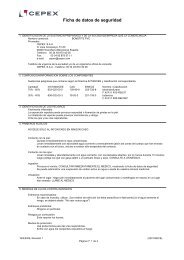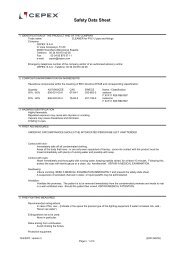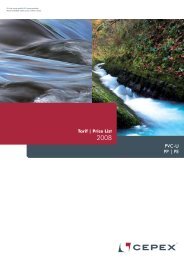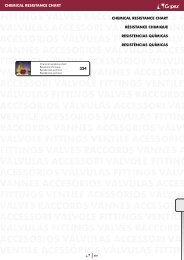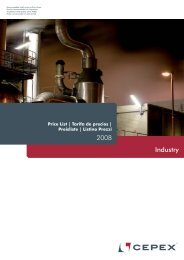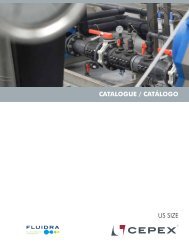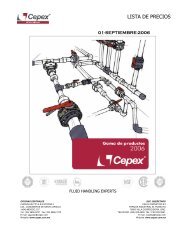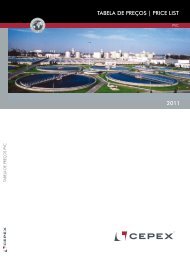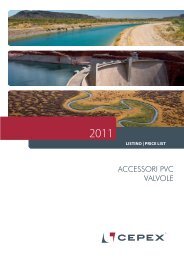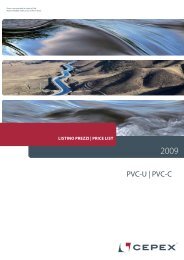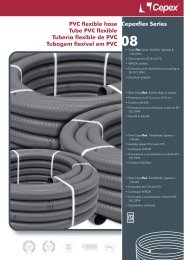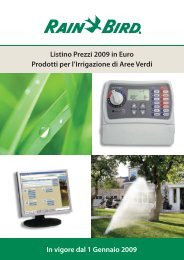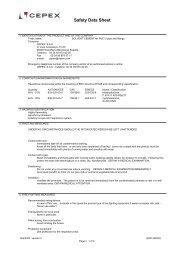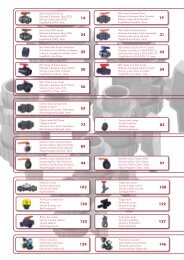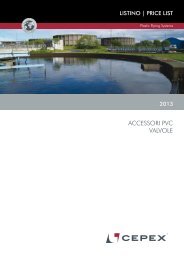PP | PE - Cepex
PP | PE - Cepex
PP | PE - Cepex
You also want an ePaper? Increase the reach of your titles
YUMPU automatically turns print PDFs into web optimized ePapers that Google loves.
A<strong>PP</strong>LICATION GUIDE GUIDE D’A<strong>PP</strong>LICATION GUIDA ALL’UTILIZZO<br />
<strong>PP</strong><br />
• Temperature range 0°C to 80°C<br />
(short term 110°C).<br />
• High impact strength.<br />
• Abrasion resistant.<br />
• Suitable for handling foodstuffs.<br />
• Ideal for above and below ground<br />
use.<br />
• Threading possible.<br />
• Resistant to acids, alkalis, salts and<br />
many organic solvents.<br />
• Good insulator.<br />
• Lightweight (density 0.905-0.92).<br />
• Not resistant to concentrated<br />
oxidising acids.<br />
• Thermal expansion is higher than<br />
other plastics.<br />
<strong>PE</strong><br />
• Wide range of sizes.<br />
• High impact resistance.<br />
• Temperature range from -40°C to<br />
+60°C.<br />
• Exceptionally resistant to abrasion.<br />
• Non-toxic.<br />
• Resistant to many acids, alkalis,<br />
organic and inorganic solvents.<br />
• Flexible and therefore suitable for<br />
buried or surface pipelines.<br />
• UV resistant.<br />
• Not resistant to strong oxidising<br />
acids.<br />
• Special welding equipment required<br />
when fusion jointing techniques are<br />
used.<br />
<strong>PP</strong><br />
• Plage de températures 0°C à 80°C<br />
(court terme 110°C).<br />
• Grande résistance à l’impact.<br />
• Résistance à l’abrasion.<br />
• Apte pour le transport de<br />
comestibles.<br />
• Idéal pour des installations<br />
extérieures ou enterrées.<br />
• Possibilité d’union vissée.<br />
• Résistant aux acides, alcalins, sels et<br />
solutions organiques.<br />
• Bon isolant.<br />
• Poids réduit (densité 0.905-0.92).<br />
• Non résistant aux acides oxydants<br />
concentrés.<br />
• Grande expansion thermique.<br />
<strong>PE</strong><br />
• Vaste gamme de dimensions.<br />
• Grande résistance à l’impact.<br />
• Plage de températures -40°C à<br />
+60°C.<br />
• Exceptionnellement résistant à<br />
l’abrasion.<br />
• Non toxique.<br />
• Résistant à de nombreux acides,<br />
alcalins et solution organiques et<br />
inorganiques.<br />
• Souple, idéal pour des installations<br />
enterrées.<br />
• Résistant aux rayons UV.<br />
• Non résistant à des acides oxydants<br />
puissants.<br />
• Une machine à souder spécifique<br />
est nécessaire pour les unions par<br />
électrofusion ou soudure bout à bout.<br />
UNIONS UNIONS UNIONI ANSCHLUSS<br />
<strong>PE</strong> and <strong>PP</strong> belong to the nonpolar<br />
materials. Thus the material does not<br />
dissolve in the usual solvents and, in<br />
addition, hardly swells. As a result, <strong>PE</strong><br />
pipes cannot be jointed by cementing<br />
with fittings. Instead, <strong>Cepex</strong> offers the<br />
following solutions in order to join <strong>PE</strong><br />
pipes:<br />
Compression<br />
Electrofusion<br />
Butt welding<br />
All these jointing techniques are<br />
detailed in their own chapter.<br />
Le <strong>PE</strong> et le <strong>PP</strong> appartiennent aux<br />
matériaux non polaires. Par conséquent<br />
le matériau ne se dissout pas dans les<br />
solvants habituels et, de plus, il se dilate<br />
difficilement. Pour cela, les tubes de <strong>PE</strong><br />
ne peuvent pas êtres unis par collage<br />
avec les raccords. <strong>Cepex</strong> propose les<br />
solutions suivantes pour des unions<br />
avec des tubes de <strong>PE</strong> :<br />
Compression<br />
Electrofusion<br />
Soudure bout à bout<br />
Chacune des ces techniques est décrite<br />
dans sa propre section.<br />
<strong>PP</strong><br />
• Rango di temperature: da 0°C a<br />
80°C (brevi periodi 110°C).<br />
• Elevata resistenza agli urti.<br />
• Resistente all’abrasione.<br />
• Può trasportare sostanze<br />
commestibili.<br />
• Ideale per installazioni esterne ed<br />
interrate.<br />
• Possibile l’unione a filetto.<br />
• Resistente agli acidi, alcali, sali e<br />
soluzioni organiche.<br />
• Buon isolante.<br />
• Peso ridotto (densità 0.905-0.92).<br />
• Non resistente agli acidi ossidanti<br />
concentrati.<br />
• Elevata dilatazione termica.<br />
<strong>PE</strong><br />
• Ampia gamma di dimensioni.<br />
• Alta resistenza all’impatto.<br />
• Rango di temperature: da -40°C a<br />
+60°C.<br />
• Eccezionalmente resistente<br />
all’abrasione.<br />
• Non tossico.<br />
• Resistente a molti acidi, alcali e<br />
soluzioni organiche ed inorganiche.<br />
• Flessibile, ideale per installazioni<br />
interrate.<br />
• Resistente ai raggi UV.<br />
• Non resistente agli acidi ossidanti<br />
forti.<br />
• E’ necessaria un macchinario per<br />
saldatura specifico per le unioni<br />
elettrosaldabili o testa a testa.<br />
Il <strong>PE</strong> e il <strong>PP</strong> appartengono ai materiali<br />
non polari. Come conseguenza il<br />
materiale non si scioglie nei normali<br />
solventi ed inoltre, difficilmente si<br />
dilata. Per questo, i tubi in <strong>PE</strong> non si<br />
possono unire per incollaggio con<br />
gli accessori. <strong>Cepex</strong> offre le seguenti<br />
soluzioni per unioni con tubi in <strong>PE</strong>:<br />
Compressione<br />
Elettrofusione<br />
Saldatura Testa a testa<br />
Ognuna di queste tecniche è descritta<br />
nella relativa sezione.<br />
9<br />
ANWENDUNGSBE-<br />
REICH<br />
<strong>PP</strong><br />
• Temperaturbereich von 0°C bis 80°<br />
(für kurze Dauer bis 110°C).<br />
• Hoch schlagfest.<br />
• Resistent gegen Abnutzung.<br />
• Im Lebensmittelsektor einsetzbar.<br />
• Optimal für über- und unterirdische<br />
Installationen.<br />
• Gewindeanschlüsse möglich.<br />
• Resistent gegen Säuren, Alkalien,<br />
Salze und verschiedene organische<br />
Lösungen.<br />
• Guter Isolator.<br />
• Leichtgewichtig (Dichte 0.905-0.92).<br />
• Nicht resistent gegen konzentrierte<br />
oxidierende Säuren.<br />
• Thermische Ausdehnung ist höher<br />
als bei anderen Kunststoffen.<br />
<strong>PE</strong><br />
• Produktreihe in vielen Größen.<br />
• Hoch schlagfest.<br />
• Temperaturbereich von -40°C bis<br />
+60°C.<br />
• Außergewöhnlich<br />
abnutzungsbeständig.<br />
• Nicht toxisch.<br />
• Resistent gegen viele Säuren,<br />
Alkalien, organische und unorganische<br />
Lösungen.<br />
• Flexibel, gerade für unterirdische<br />
Installationen.<br />
• Beständig gegen UV-Strahlung.<br />
• Nicht resistent gegen stark<br />
oxidierende Säuren.<br />
• Notwendig: spezifisches<br />
Schweißgerät zum Verschweißen<br />
von Heizwendelschweiß- oder<br />
Heizelementstumpfschweißmuffen.<br />
<strong>PE</strong> und <strong>PP</strong> gehören zu den unpolaren<br />
Werkstoffen. Auf Grund dessen löst sich<br />
dieser Werkstoff nicht in gewöhnlichen<br />
Lösungen und schwillt dazu kaum an.<br />
Daher sollten <strong>PE</strong>-Rohre nicht mit den<br />
Muffen verleimt werden. CE<strong>PE</strong>X bietet<br />
folgende Lösungen für Anschlüsse an<br />
<strong>PE</strong>-Rohren an:<br />
Klemmverbindung<br />
Heizwendelverschweißung<br />
Heizelementstumpfverschweißung<br />
Jede Verbindungstechnik wird detalliert<br />
in einem separaten Kapitel geschildert.



